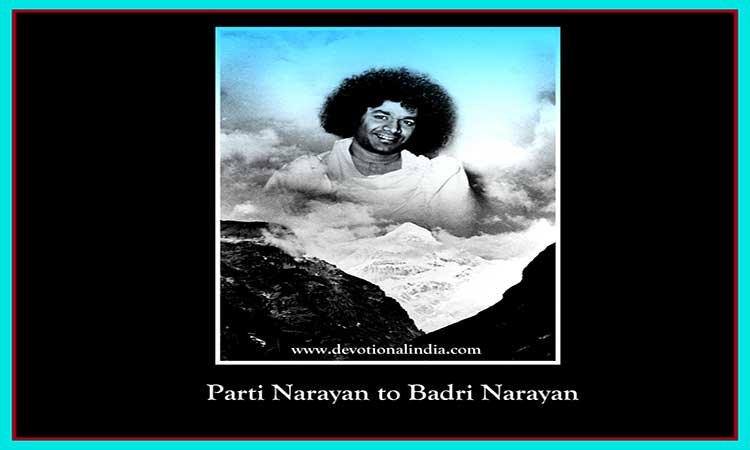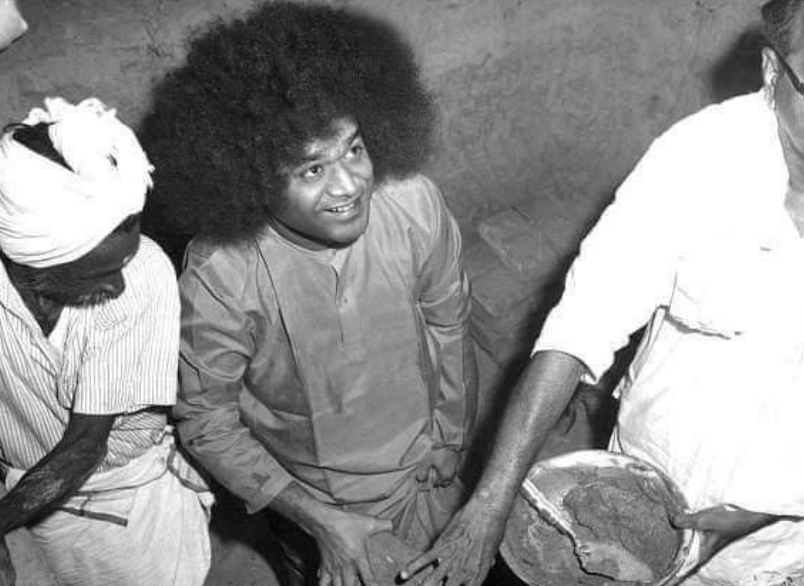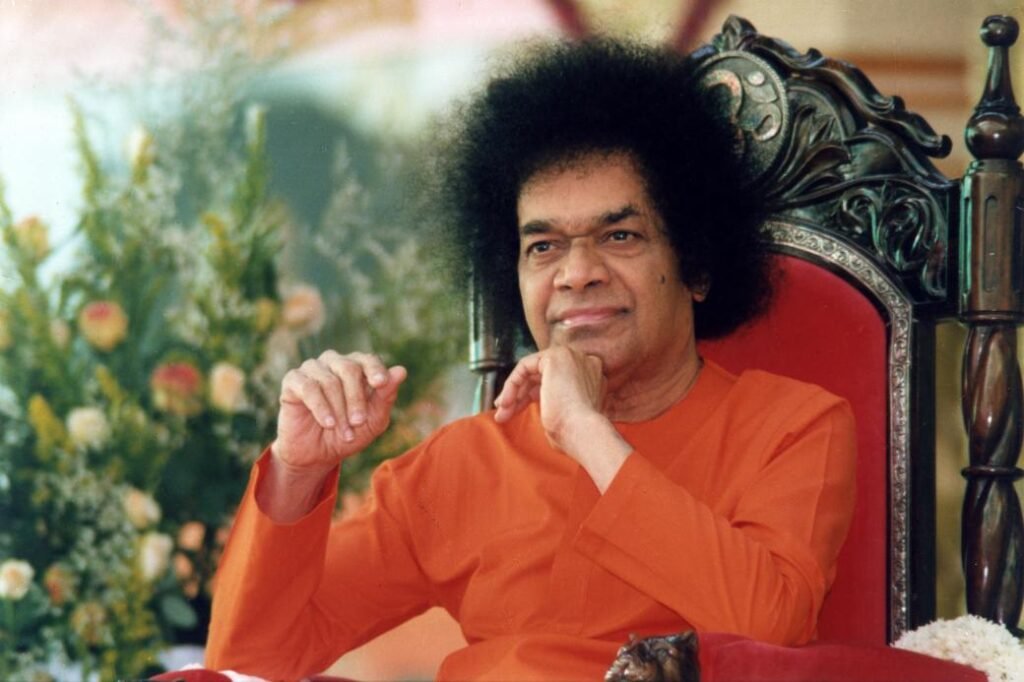The Concrete Badri Narayan
The Concrete Badri Narayan
Om Sri Sai Ram

17th June [1958] was a Day of Days, a Day that will be enshrined in the memory of everyone in the party, for years and years. In pursuance of His Mission of re-infusing spiritual efficacy in all Holy Places where men congregate for acquiring peace and joy, a Mission which took Him recently to Ayodhya, Kasi and Prayag, Baba that day re–invigorated Narayana worship at Badrinath, by means of a unique cermony, whose significance is beyond our tiny understanding!
During the morning Abhishekam to the idol of Badrinarayana, while Baba was inside the temple facing the shrine, about 8.15AM, Baba mysteriously materialised a four armed Narayana icon with Sankha, Chakra, Gada and Padma, about 12 inches, perhaps sublimating in that form the Divine Essence of the Narayana Tejas before Him. He also created a charming thousand petalled ‘gold’ Lotus, and before the wonder of the people around Him could express itself in an awe striken gasp, He waved His hand before the Shrine and, lo, there was a Jyothirlinga in His palm, which He placed on the shining Lotus. Baba came away to the Dharmasala with the devotees and the large number of officers and citizens of Badrinath. Their Excellencies also soon joined the gathering.
The Badri idol, the nethra lingam and the thousand petalled Lotus
Materialising a ‘silver’ Abhisheka Vessel full of holy water from Gangothri itself (as He announced), Baba Himself performed Abhisheka to that translucent Nethra Lingam. He had graciously taken the Linga round to everyone and made all to wonder at its quit effulgence and at a clearly visible Eye that was somehow incorporated in it. Devotees recited Sri Rudram, Purushasuktham and Narayana Suktham, while Baba was pouring the sacred water on the Lingam. Then, Baba created 108 miniature Bilva leaves or rather replicas of that holy leaf, in ‘gold’; they fell in a lightning shower from His Palm on to a silver plate.
The golden bilva leaf manifested by Baba
He again waved His Hand and this time, O Blessed moment, 108 actual ‘thumme’ flowers fresh with even the touch of the morning dew, fell from that Divine Palm! With these, Baba directed Dr.B.Ramakrishna Rao, presumably on behalf of all assembled to do Puja to the Linga, the Ashtottara Puja, as mentioned in the Sastras. After Puja, Baba collected the Abhisheka Ganga and gave a share of it to each one, Himself pouring it into the mouth with His own merciful Hand.
Displaying the Lingams that He created at Badri
Needless to say, the Lingam, one of the Five, which according to Baba, Sankaracharya brought from Kailasa, and which he installed in a sacred spot in the shrine to vivify the Badarikasram returned to the place from which Baba had drawn it for this epoch making ritual of re invigoration. The Lotus and the Icon, He granted to the devotees; the Bilva leaves of ‘gold’ He gave to members of the party, as mementoes of the Momentous Day, for being duly worshipped by them.
About 12.30PM, the same day, Baba condescended to come to Brahmakapal, where the devotees had arrived to offer oblations to the pitris (forefathers). He advised everyone to pray for their ancestors and departed relations, in a spirit of faith and sincerity. Every member of the party had a rare good fortune of paying off the debt to the departed in the immediate presence of the Lord Himself!
Then Baba went down to the Alakananda and took from the surging torrent a glass of water, but, lo! The glass held also a lump of Vibhuthi with the mark of Pranava on it and the til essential for ancestral rites! He poured the water on to the palms of the devotees who were handicapped by disqualifications form partaking in the Pinda Pradan, asking them to offer that water instead! Surely, the manes of all who shared in that day’s Brahmakapal ceremony are thrice blessed!

In June-July 1961, Baba toured North India and visited many holy shrines in Haridwar, Srinagar, Rishikesh, Badrinath and Nainital. The purpose of the visit, in Baba’s own words, was to “charge the exhausted spiritual batteries of the temples”. Prof. N. Kasturi who was among the fortunate few who accompanied Baba on this trip recounts the astounding events that took place when they visited the shrine at Badrinath:
‘The visit to Badrinath was first mooted by Baba in 1958, at a Bhajan session held on the sands of the Chithravathi. He said then that He would take the Bhakthas (devotees) to the place where He was doing Tapas (penance) and everyone present there was wonder struck, for that was the first time they had ever heard of Tapas, associated with His earthly career.
Every one until then was convinced that Baba indulged in no Tapas, here or anywhere, corporeally or extra-corporeally! But by the time the tour ended they had understood the actual import of Swami’s statement and the great significance veiled in it.
Once the visit became a certainty, plans were ready and the party fixed, before the end of May. Since the pilgrimage to Badrinath involved a week long journey by train and bus and an exhausting climb of about 20 miles, Baba chose only a minute fraction of the hundreds of devotees who prayed to be given the chance to join Him.
Baba greeted the fortunate few with His Darshan at the Ethiraja Kalyana Mantapam, Alwarpet, Madras (now Chennai) on the 7th day of June, 1957 and sent them by train to Delhi, where He promised to bless them personally, since He proposed to fly to the Capital, the very next day.
The train reached Delhi about six hours late and when the hungry, tired and distracted devotees arrived at last, they found Baba shedding cool comfort and consolation and strength by His Smile and His Motherly attention.
The next day, at Hardwar, the Governor of Uttar Pradesh, Dr. B. Ramakrishna Rao, joined Baba, for he too had planned a visit to Badrinath. On 11th June, Baba and His Excellency attended the evening Arati to Gangamatha at the Brahmakund; the vast assemblage of pilgrims got the Darshan of Baba at that holy spot; Baba blessed the priests and Archaks with the Vibhuti that He materialised and He sprinkled the sacred waters of the Ganges on those around Him.
That night, Baba called together the devotees who were to accompany Him to Badri and reminded them of the rare privilege that they had won. “You have the good fortune of proceeding with the Manifested Form to the Unmanifested Form whereas usually, people pray to the Unmanifested Form, immanent in the idol, to manifest itself before their eye, so that they might win the fruit of their Sadhana.” He declared.
The chosen few were thrilled with joy at the revelation. He then described in great detail the sacred shrine to which He was leading them, as if He knew every nook and corner of the holy area. When He disclosed that Narayana was there depicted as in Tapomudra, as doing penance, and explained that it was called Badarikasram on account of this, the devotees began to see light, and the doubt that assailed them on the Chitravati sands three years ago about Sathya Sai Baba and Tapas melted away in a blaze of joy.
img src=”internal/The-golden-bilva-leaf.jpg”/>
Baba spoke also of the subsidiary shrines in and around Badrinath and also of certain unknown aspects of its sacredness. For example, no guidebook has published the information that Sankaracharya brought from Kailash five Lingams and that he installed one each at Badri, Puri, Sringeri, Dwaraka and Chidambaram, but Baba revealed this fact that night. Baba planted in every heart the pilgrim mood of prayer of brotherhood and loving service.’
Prof. Kasturi in “Sathyam Shivam Sundaram” explains day-wise details of their journey from the 7th of June. But now, let’s go to the heart of the story, the 17th of June:
‘The 17th was in fact the day of days, the day selected by Baba for re-infusing spiritual efficacy, for charging the run-down battery.
During the morning Abhishekam at the shrine, Baba who was sitting facing the idol materialised a beautiful four-armed Narayana Idol, with Sankha Chakra Gada and Padma (conch, wheel, mace and lotus), and idol of supreme craftsmanship.
Then, in a trice, He created a Golden Lotus, a thousand petalled one, beautiful beyond all imagination. We all wondered why the Lotus appeared; but, before our wonder could find expression in a gasp, Baba waved His hand again.
This time there was a Lingam in His palm, evidently the same that Sankaracharya had planted in the stone cavity over which the Narayana idol was placed inside the Badri Shrine. This last He placed in the centre of the Lotus and both the Lotus and Idol placed on a silver plate appeared to have been made for each other.

There were large groups of pilgrims pressing to enter the tiny hall before the shrine. In order that they might have access, Baba proposed to ‘charge the battery’ (revitalise the Lingam with spiritual energy) at the Gujarat Dharmasala where the party stayed.
There Baba directed bhajans to be done and while the praise of Narayana was being sung, He rose from the floor, saying, “Now we shall consecrate this Lingam again“.
process of recharging’, Sri Kasturiji writes in Loving God, ‘which over two hundred witnessed, was most exhilarating. He showed the Lingam to every one, bringing It Himself near each person, and pointing out to all the translucence of the material and the form of an Eye, that was mysteriously incorporated inside it! He called it the Nethralingam from Kailash.
He drew the devotees’ attention to the Eye that could be clearly seen inside it, the black shining retina on the white background and the tapering end with the lids both upper and lower. When Baba turned the Lingam to right or left, the eye seemed to roll in the same direction. “Has everyone seen it?” He asked. “If you haven’t, come here”, He invited. “For, it has to go back to where Sankaracharya placed it,” He announced.
Then, while Badrinath echoed with Bhajans sung by devotees, Baba rose with a silver pot in His Hand a pot that had come into His palm when He willed. He came near the table where the Silver plate with the Lingam on the Lotus was visible to all. He said, The pot contained holy water from the Gangotri, the spring in which the Ganga is born. He released His finger from under the pot and, lo! a hole was formed there to allow a stream to fall on the Lingam as ‘Abhishekha’ (ceremonial bath of the idol). The pundits and priests recited Vedic hymns prescribed for the rite.”
After Abhishekha, next was Puja (ritual worship). Baba materialised for the Puja 108 Bilva Leaves (considered sacred for worship of Lord Shiva) made of gold; they fell in a scintillating shower from His Divine Hand on to the silver plate beneath! Again, the Hand was waved!
This time, the shower consisted of a heap of “Thumme” (Leucas Linifolia) flowers, with the dew still fresh upon them, tiny bits of fragrant fluff, plucked with care from a hundred little tropical plants!
These dew-dipped thumme flowers with which devotees at Puttaparthi worship Baba are generally found only on the balding hills and dry plains of South India. The Puja was performed, on behalf of all present, by Dr. B. Ramakrishna Rao, while appropriate Manthrams like Rudram, Narayana Suktham and Purusha Suktham were being recited all the while by the devotees.
Baba then declared, “Now, the Lingam will return,” and the Netralingam was sent back into the secret niche where it was installed by Sankaracharya 1200 years ago. When it suddenly disappeared, Baba explained to the devotees that the purpose for which it was drawn out had been fulfilled with the completion of the ritual aforesaid.
It had been charged with immense potency and the Temple consecrated anew by the Manifested form Himself.”





















































